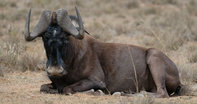
Black Wildebeest
Name
Black wildebeest or white-tailed gnu (Connochaetes gnou)
Appearance
Black wildebeest are dark brown to black in colour, with an upright mane and a long blonde tail. Calves’ horns are straight until about nine months of age when they start to develop their characteristic curve. Both bulls and cows have heavy horns curving forward. At the shoulder, bulls measure approximately 1.2 metres and weigh 160 kg. Cows are naturally smaller, measuring 1.16 metres and weighing 130 kg.
Black Wildebeest Diet
Black wildebeest are primarily grazers eating short grass and occasionally shrubs and herbs.
Black Wildebeest Behaviour
There are three types of herds to which the black wildebeest may form a part of. Dominant bulls and territorial bulls form herds in which they compete to attract cows, yet cows form solely female herds and bulls may make bachelor herds as well. Older bulls are normally more isolated from the social structures. Black wildebeest show attachment to particular areas of land, preferred for visibility to enhance safety. Dominant bulls locate themselves in a grid format across their territories, actively defending their area.
Black Wildebeest Habitat
Black wildebeest prefer open grassveld and avoid areas of tall grass and dense vegetation inhibiting their panoramic visibility.
Where they are found
The black wildebeest is endemic to South Africa, historically having inhabited the open grasslands of the Northern Cape, Free State, southern Highveld regions, western Lesotho and Swaziland, and the areas of grassveld below the Drakensberg in Kwazulu-Natal. The black wildebeest has recently started to inhabit other areas of South Africa and its neighbouring countries, and not threatened by extinction.
Field Notes
Having been removed from their natural habitat due to farming practices and developments, the black wildebeest can now predominantly be found on private land and game farms, where they are bred. Although the black wildebeest could be found in great numbers in the grassveld of central South Africa, they never migrated like the blue wildebeest. The black wildebeest has been trans-located as far as Kenya.

